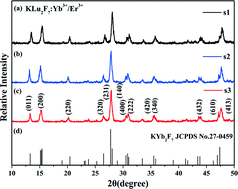Controllable synergistic effect of Yb3+, Er3+ co-doped KLu2F7 with the assistant of defect state†
Abstract
A series of Yb3+, Er3+ co-doped KLu2F7 nanoparticles (NPs) with different morphologies (hexagon and stick-like structures) and sizes are prepared by a facile additive-assisted hydrothermal route. The synergistic effects of ultraviolet (UV) light down-conversion and infrared (IR) up-conversion in Yb3+, Er3+ co-doped KLu2F7 NPs under the dual excitation of 377 and 980 nm simultaneously are investigated. The optimized emission intensity of Er3+ with the most regular morphologies under the dual wavelength excitation is 1.16 times of the total emission intensities under single excitation of 377 and 980 nm. More interesting, a sharp increase in the number of photons as a quasi-photon avalanche (QPA) phenomenon is observed by employing the dual wavelength excitation sources. Thermo-luminescence technique results experimentally verify that there are structure defects acting as deep traps capturing carriers, contributing to the QPA. The phenomenon of QPA disappears after the sample annealed at 300 °C and as a result of that most of the deep traps are eliminated, which provides further evidence of the roles that traps play in the photoluminescence process. We believe that this preliminary study will provide an important advance in grasping defects of NPs anticipating the up- and down-conversions processes involved in increasing photovoltaic efficiency of solar cells.


 Please wait while we load your content...
Please wait while we load your content...